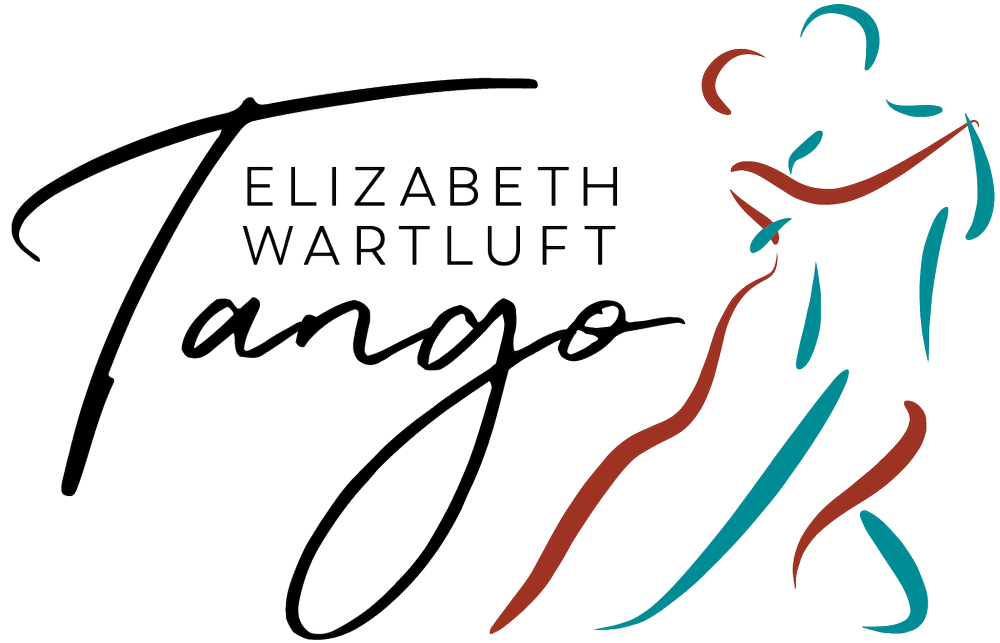I only teach ganchos once a year or so, but it’s been almost three because of COVID. A gancho looks like a much bigger move than it is, and I often see people doing versions that can injure the body. It’s good to understand how to lead and follow ganchos and then decide if/how you want to use them. Here is a quick summary of what we covered in class last week.
The free leg starts at the hip joint and pelvic floor
The gancho, or “hook” in tango, is a whole-leg movement for the follower. Even though it looks like you do a hamstring curl around the leader’s leg, this is about having a leg that is free at the hip joint. If the hip is tight or constricted, the gancho will look awkward.
Your core and pelvic floor need to be engaged to have room to allow the hip to open so that the leader can move the follower’s leg. Your best preparation for doing a good gancho: practice back steps with your pelvic floor lifted. If you are doing your best back step, the leader can produce your best gancho!
Practice for a free leg
It’s hard to practice ganchos solo, but you can practice having a free leg. Stand on a step or a book or anything that lets you truly dangle your leg from the hip joint. Lift your pelvic floor, and you should be able to feel that free hip joint even more in comparison. This also prevents your lower back from taking part in the gancho instead of your hip joint.
After you locate the hip joint this way, stand tall on the floor with your pelvic floor lifted, and feel your leg still dangle, but now touch the floor. Hold onto something and use your other hand to push your relaxed, free leg. Notice how long it takes to start your leg moving! The gancho is not an instantaneous move. You see the moment where the leg is moving the fastest (at the end of the move) and the brain is tricked into thinking that the entire move is fast. Take your time to move that 30-40 lbs. of leg with a FREE hip joint!
The gancho is ALWAYS an invitation
Students often ask how to “make” a follower do a gancho. The gancho is always an invitation. For a gancho to work, I need to be able to stand on my axis as the leader sets up the gancho request. If the leader has put me in a position where I might be in danger of falling, I will refuse a gancho even when I know the leader wants one. I might also refuse a gancho if I feel uncomfortable with having that leader that close to my legs. I know some dancers who grew up in conservative countries or who are shy who cannot bring themselves to gancho. Leaders: respect the follower’s decision!
Make a gancho the follower can’t resist!
As a follower, I can’t produce a good gancho if I am afraid of falling over. The leader needs to offer a gancho that does not knock the follower off axis. If someone sets up a good gancho, I will accept that invitation.
Stay close to the follower rather than lunging through their legs: a tall, skinny window of space is best for a gancho. If the leader squats and goes low for the gancho, the follower will not feel or look elegant! In teacher training, Chicho Frumboli always told us to “bring the follower to you instead of going to the follower” and he meant that the steps BEFORE the gancho should create a situation where the axis of the leader and the axis of the follower were as close as possible and on balance.
A good place to start is from the stepover (pasada) as the follower steps forward over your foot from a front parada. Most dancers can stay close for this step. You can also do a gancho from an overturned ocho or in the back step of the turn (giro), but many followers struggle to do good turns and may not be on balance enough to stay close in this move.
If you struggle to stay close, consider using the “other” leg for the gancho, leaders! Flip around 180 degrees and offer a gancho to the back of your leg! If this does not make sense, come to class Thursday!
Don’t autogancho!
Followers have spiked me twice in the past two weeks by someone who thought I was offering a gancho because they felt my ankle against their ankle. I am surprisingly good at jumping out of the way if someone winds up for an autogancho, but I still got kicked. Ouch.
For a gancho, the invitation needs to connect with the instep, foot or ankle (depending on style) AND be against the leg, preferably as high as possible, at the hip joint of the follower or near that. If you don’t feel a back-of-the-leg connection followers, DO NOT create a gancho yourself because you will hurt the leader!
There’s a lot more to ganchos, and many variations, but these are the main points I would want every dancer to know. Come to class and we will do the rest together!
